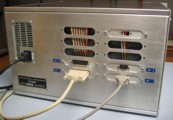
Technical Hobby
Web Site
Links
 |
John
Doran's Technical Hobby Web Site |
Home Links |
| D16/M Minicomputer Page.
Click
on pictures to get larger/higher quality images. |
|
The D16/M is a general-purpose,
stored-program,
single-address, 16-bit digital
computer using two's complement arithmetic. It
manages subroutine calls and interrupts using a memory stack. The
processor may directly address 64K words of memory or I/O.
Its timing and control unit is
microprogrammed (fully horizontal, with a 72-bit control word). As presently configured, the D16 has 73 unique processor instructions. There are eight addressing modes: Implied, Immediate, Direct, Indirect, Post-Incremented Indirect, Direct Indexed, Indirect Indexed, and Post-Incremented Indirect Indexed (see the D16 Instruction Set for details). The machine is implemented in SSI and
MSI
HCMOS integrated
logic and constructed using wire-wrap techniques. It is packaged in a 6U (10.5 inch)
rack-mount
enclosure, and has a 100-pin bus for main
memory (CMOS
SRAM) and peripheral interfaces. Photos and additional details of the D16/M
main memory module and peripheral
interface modules may be found on the separate D16/M Peripherals Page. |
 |
« Finally, here is a look at the rear of the cabinet. There are cutouts in the back panel for mounting interface connectors, and a military-style engraved aluminum serial-number plate! |
| The D16/M
documentation follows. All docs are in Adobe PDF format, except
those
specifically indicated otherwise. D16_regs D16 register architecture ("block diagram") D16_instr D16 instruction set. D16_state D16 processor state diagram. D16_ops D16 processor microcode source listing. D16_prog D16 processor microcode ROM contents listing. D16_uinstr D16 processor microcode bit ROM bit functions ("microinstruction set"). D16_uprog_guide Detailed Microprogramming Guide for the D16 processor. D16_bus D16/M external bus connector pinout. D16_TBL (ASCII) D16 Processor function table for CROSS-32 meta-assembler. CPU_SCH Schematic diagram of the D16/M main processor board. PANEL_SCH Schematic diagram of the D16/M front panel board. MEM_SCH Schematic diagram of the D16/M main memory/bus terminator board. 2PULSE Schematic diagram of the switch-debounce Programmable Logic Device. D16_cpubd_layout Component layout for the D16/M main processor board. D16_fpbd_layout Component layout for the D16/M front panel board. D16_fp_art Artwork (graphics) for the D16/M front panel. D16_panel_functions Description of the D16/M front panel controls and indicators. D16_FAQ (HTML) D16 Frequently-Asked Questions. D16_design_notes (HTML) D16 Design and Construction Notes. D16_changes (HTML) Changes and update information. wire_wrap (HTML) A general discussion of wire-wrap construction. |
| Copyright TimeFracture 2004,
2005. |